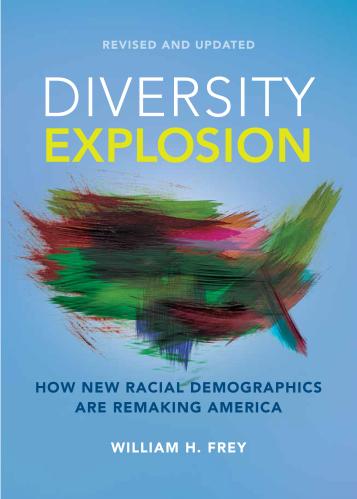Contents
- Introduction
- Smaller and non-metropolitan areas saw a population rebound
- Suburban and exurban growth is outpacing urban growth once again
- Immigration is driving population growth in more areas
New Census Bureau population estimates for counties and metropolitan areas confirm that after concentrating in big cities and major metro areas during the first part of this decade, Americans are spreading out again into suburbs, exurbs, and smaller towns and rural areas.
The new numbers, which track annual population trends through July 2018, indicate that for the first time this decade, the nation’s three largest metropolitan areas—New York, Los Angeles, and Chicago—all lost population. At the same time, outer suburban, exurban, and non-metropolitan counties nationwide registered renewed growth. Although there are some exceptions in growing parts of the country, the latest data reveal that broad-based population “concentration” toward large urban areas in the early 2010s was an aberration related to the post-recession economy and housing crunch.
Because these trends largely reflect shifts in domestic migration within the United States, immigration from abroad is increasingly counteracting population decline for areas experiencing out-migration.
Smaller and non-metropolitan areas saw a population rebound
Prior to the Great Recession of 2007-2009, smaller metro areas were growing faster than larger ones, and non-metro area growth was on the upswing (see Figure 1). However, the punishing impact of the housing bust and ensuing recession on job availability put the brakes on population dispersal, especially to rural towns and small places tied to cyclical industries such as manufacturing and farming.

Beginning in 2007, large metro areas (with populations exceeding 500,000) exhibited higher growth rates overall than smaller metro areas. For much of the earlier part of the current decade, growth rates in small metro areas declined, and non-metro areas actually shrank.
These patterns began to reverse after the middle of the decade as the economy and housing market picked up steam. The new numbers show that, for the past two years, growth rates have declined in large metro areas (which now collectively exhibit net domestic out-migration), while non-metro areas have gained population after six years of losses and almost unprecedented levels of out-migration.
For the past two years, growth rates have declined in large metro areas (which now collectively exhibit net domestic out-migration), while non-metro areas have gained population after six years of losses and almost unprecedented levels of out-migration.
Of course, metro areas vary widely in their growth. Among the nation’s 100 largest in 2018, Dallas led all others with a gain of 131,000 people. Several other Sun Belt areas, including Phoenix, Houston, Atlanta, and Orlando, Fla., Seattle, and Washington, D.C. also cracking the top 10 (with gains of at least 50,000) (download Table A). Still, 16 of the 100 largest metro areas lost population, a similar number to the previous year, and up from just four population losers in 2009-2010. These include the nation’s three largest metro areas, New York, Los Angeles, and Chicago, the last of which has now lost population for four consecutive years.

Notably, the majority of large metro areas, including big gainers, exhibited smaller gains in 2017-2018 than during the last big high-concentration year: 2014-2015 (download Table A). Among the 20 metro areas with the largest population gains, only five—Phoenix, Las Vegas, Riverside, Calif., Minneapolis-St. Paul, and Jacksonville, Fla.—added more residents in 2017-2018 than in 2014-2015.
Suburban and exurban growth is outpacing urban growth once again
The latest 2018 census estimates also show that as population shifts from larger to smaller metro areas, within the nation’s largest metro areas, people are also shifting from the urban core toward outer suburbs and exurbs. Urban core county growth was low and outer emerging suburban and exurban growth peaked in the years before 2007.1 Thereafter, urban core county growth more than doubled from 0.4 percent to almost 1 percent in 2010-2011, and remained above 0.8 percent through 2014-2015. At the same time, growth rates in exurban counties dipped from 1.4 percent prior to the recession to 0.07 percent in 2011-2012, and hovered below 0.6 percent through mid-decade.

Over the past three years, as the suburban housing market improved, suburban and exurban growth rates rose to exceed 1 percent at the same time urban core growth dropped to 0.3 percent in 2017-2018.
Again, this aggregate experience does not apply to all parts of the country, but it is fairly pervasive. Figure 4 depicts changes in two New York City boroughs, Brooklyn (Kings County) and Queens (Queens County), both known for recently attracting young millennial professionals. Both experienced healthy growth in the vicinity of 1 percent a year early in the decade, but lost population in the last two years, in large part due to accelerating domestic out-migration.

These counties portray a broader pattern around the country. Among 68 urban core counties with populations exceeding 500,000, 50 showed either slower growth or greater declines in 2017-2018 than in 2014-2015 (download Table B). Some of the bigger drops between these two points in time occurred in Harris County, Texas (in metro Houston) from 2.2 to 0.7 percent; Denver County, Colo. from 2.8 to 1.3 percent; San Francisco from 1.5 to 0.5 percent; and Gwinnett County, Ga. (in metro Atlanta) from 2.0 to 1.1 percent.
For the first time since 1970, Washington, D.C.’s population exceeded 700,000 (702,455), a 23 percent jump from its year 2000 low of 572,059. However, much of Washington’s gain occurred earlier in the decade when annual growth rates exceeded 2 percent, as suburban housing opportunities dried up and jobs in other Sun Belt regions fell off. Washington, D.C.’s 1.3 percent growth in 2017-2018 is the lowest it has registered in 10 years.
Immigration is driving population growth in more areas
Changes in any area’s population result from three factors: domestic migration within the U.S., immigration from abroad, and natural increase (the excess in the number of births over deaths). Of these factors, domestic migration tends to change most rapidly, as movers are strongly sensitive to ups and downs in the economy. Immigration trends change more gradually, because immigrants tend to move to where there are existing immigrant communities of the same nationality, and respond to more long-term economic circumstances. Natural increase levels are the slowest to shift, though the aging of the U.S. population will lower its contribution to population growth over time.
Domestic migration’s changing contribution to recent population trends is depicted in Figure 5, which compares immigration and net domestic migration rates for different metro and non-metro categories. Since 2011-2012, net domestic migration has declined for large metro areas, and has turned negative over the past two years. Meanwhile, net domestic migration started positive this decade and rose sharply for small metro areas, and shifted from strongly negative to nearly zero for non-metro areas. In these ways, domestic migration has been the engine behind the population shifts among these areas described above.

Immigration, on the other hand, represents more of a stable contributor to population growth over time. It therefore serves an important role in fueling population growth in areas that are experiencing domestic migration losses, particularly large metro areas.
From 2010 to 2018, of the 91 large metro areas that gained population, 15 would have lost population were it not for immigration (download Table C). That is, the combination of natural increase and net domestic out-migration was not enough to achieve population gain; immigration changed a potential population loss into a real population gain. These immigration-dependent areas include New York and Chicago (which gained population over this 8-year period) as well as Philadelphia, Detroit, St. Louis, and Milwaukee. Moreover, in another 11 large metro areas, immigration drove more than half of population growth, and in 59 of the 91 growing metro areas, immigration accounted for at least 20 percent of growth.
From 2010 to 2018, of the 91 large metro areas that gained population, 15 would have lost population were it not for immigration.
Immigration contributions were not just confined to large metro areas. Of the nation’s full list of 383 metro areas, 299 gained population. Immigration accounted for all of the gain in 39 of these, and more than 20 percent of the gain in 173 places. As immigration continues to extend into different parts of the country, it will play an even greater role in contributing to growth in areas large and small as the overall population spreads out.
The map below depicts contributions of immigration across the nation’s 3,100+ counties. Since 2010, 1,479 counties gained population. In 343 of those counties, immigration accounted for more than half of recent growth, and in 652 it accounted for more than one-fifth of recent growth. While these include many large and coastal areas, they also include large parts of the South, upper Midwest, and Mountain West. Similarly, immigration serves to reduce losses in many counties. Of the 1,662 counties that lost population over the 2010-2018 period, immigration stemmed losses by at least 50 percent in 272 counties, and by at least one-fifth in 486, including many in the nation’s slow-growing Heartland.

The Census Bureau’s latest population estimates demonstrate that America’s renewed population dispersal is real. Growth in major metro areas and urban cores evident earlier in the decade are diminishing; and renewed growth is occurring in suburbs, exurbs, and more small towns and rural areas. As domestic migration drives these shifts, immigration is becoming an even more important contributor to growth in both large urban areas and smaller-sized regions with otherwise stagnant or declining populations.
Thanks to Cathy Sun and John P. DeWitt of the University of Michigan Population Studies Center for programming and data preparation assistance.
-
Footnotes
- The Brookings urban classification of counties within the 100 largest metropolitan areas consists of urban core (counties that are at least 95 percent urbanized); mature suburbs (75 percent to 95 percent urbanized); emerging suburbs (25 percent to 75 percent urbanized); and exurbs (less than 25 percent urbanized).
The Brookings Institution is committed to quality, independence, and impact.
We are supported by a diverse array of funders. In line with our values and policies, each Brookings publication represents the sole views of its author(s).







